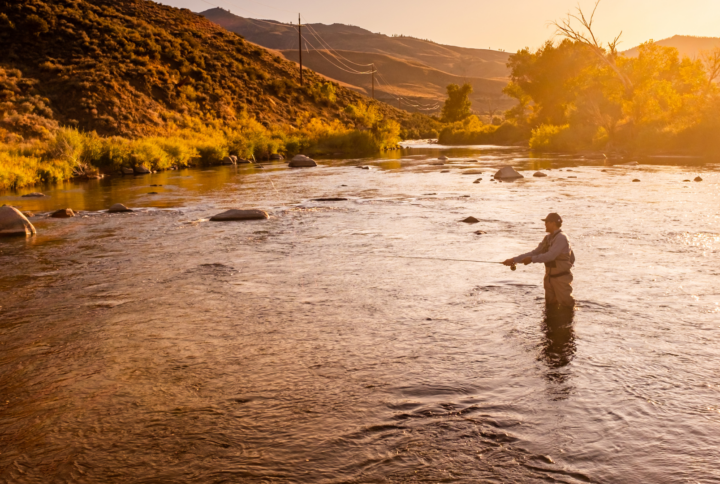Madison River - West Yellowstone - Montana
Fly Fishing River Report & Conditions
Madison River – West Yellowstone - Water Flow Chart
Madison River – West Yellowstone - Weather report & radar
Madison River – West Yellowstone - General hatch chart
| Month | Hatch | Time of Day | Recommended Fly Sizes | Popular Fly Patterns |
|---|---|---|---|---|
| January | Midges | Afternoon | #18-22 | Zebra Midge |
| February | Midges | Afternoon | #18-22 | Zebra Midge, Griffith’s Gnat |
| March | Midges, Blue Winged Olive | Afternoon | #18-22, #16-20 | Zebra Midge, Griffith’s Gnat, BWO Emerger |
| April | Blue Winged Olive, Midges | Midday | #16-20, #18-22 | BWO Emerger, RS2, Zebra Midge |
| May | Caddis, Blue Winged Olive | Afternoon | #14-16, #16-20 | Elk Hair Caddis, X-Caddis, BWO Emerger |
| June | Salmonflies, Golden Stoneflies, Caddis | Midday – Evening | #6-10, #10-14, #14-16 | Rogue Foam Stonefly, Elk Hair Caddis, X-Caddis |
| July | Golden stoneflies, Pale Morning Duns, Terrestrials | Midday | #10-14, #16-20, #10-16 | Rogue Foam Stonefly, PMD Sparkle Dun, Dave’s Hopper |
| August | Tricos, Terrestrials | Early Morning, Midday | #18-24, #10-16 | Trico Spinner, Dave’s Hopper, Chernobyl Ant |
| September | Tricos, Terrestrials | Early Morning, Midday | #18-24, #10-16 | Trico Spinner, Foam Beetle, Chernobyl Ant |
| October | Blue Winged Olive | Afternoon | #16-20 | BWO Emerger, RS2 |
| November | Midges | Afternoon | #18-22 | Zebra Midge |
| December | Midges | Afternoon | #18-22 | Zebra Midge |
Madison River – West Yellowstone Access Points
Famous for its trout, the Madison River in West Yellowstone provides an exceptional fly fishing experience. Here are the best access points:
- Madison Junction: Easily accessible and possesses good fish variety.
- Seven Mile Bridge: Offers excellent wade opportunity and heavy brown trout population.
- Raynolds Pass: A renowned access point with abundant parking space, but gets crowded during the season.
- Lyons Bridge: Convenient access and less busy than some other locations.
Also, consider the following locations where there’s no bridge access:
- Moose Creek: Known for its quiet environment and possibility of high trout count.
- Pine Butte: Offers amazing walk-and-wade fishing experience and ample parking space.
Madison River – West Yellowstone Fishing Spots
The Madison River, West Yellowstone offers a myriad of fishing spots renowned amongst fly fishing enthusiasts. Notably, the best spots to indulge in this leisure activity include:
The Upper Madison: Stretches from Quake Lake to Ennis Lake. Popular locations are Raynolds Pass, Lyons Bridge, and Warm Springs.
The Lower Madison: Begins at Ennis Lake and ends at Three Forks of the Missouri. Bear Trap Canyon is a prime fly fishing area here.
The Channels Section: Located below the Ennis Bridge. Known for consistent fly hatches and excellent fish populations.
Each location presents diverse features suitable for different levels of fly fishing expertise, and all are renowned for their abundance of trout. Whether a novice or seasoned angler, the Madison River offers unmatched fly fishing opportunities.
Madison River – West Yellowstone Local Fish Species
- Brown Trout
- Rainbow Trout
- Cutthroat Trout
- Whitefish
- Yellowstone Cutthroat
- Mountain Whitefish
- Arctic Grayling
- Salmon Fly
About the Madison River – West Yellowstone
The Madison River – West Yellowstone has a rich history dating back thousands of years, known for its incredible beauty and bountiful wildlife. Hunters, gatherers, and other natives once thrived by its shores before European explorers discovered it around the 18th century. As one of the three rivers feeding into the Missouri, it played a pivotal role in the Lewis and Clark Expedition.
The river was eventually named after James Madison, the fourth US President, by Meriwether Lewis. In the following years:
- Prospectors, settlers, and traders used the river as a transport hub during the gold rushes.
- Fishing enthusiasts began to flock to it in the early 1900s, drawn by the abundance of trout.
- In much more recent history, it became a destination for river rafting and other water sports, contributing significantly to West Yellowstone’s tourist industry.
Today, the Madison River continues to remain a cherished testament to America’s expansive natural beauty.
Community Contributions
Be part of the fishing community-
Submit your update!
Coming Soon



